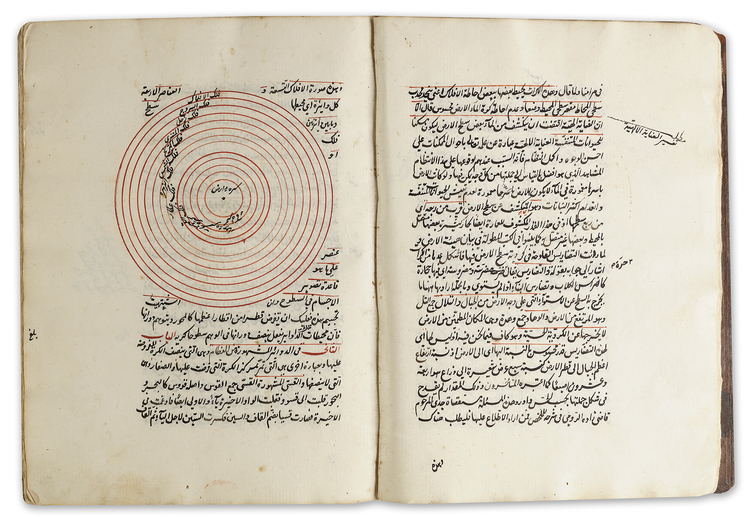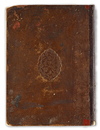A MANUSCRIPT EXPLAINING THE FATIHIA MESSAGE IN THE ASTRONOMY
Arabic manuscript on paper, 112 leaves, 21 lines to the page written in naskh script in black ink and the illustration is in red
with 30 detailed geometric drawings in red ink, in brown leather binding with stamped central medallions incorporating stylized vegetal and floral motifs.
15 by 20 cm.
Sharh al-Fathiyya fi’Hay’a – A Commentary on Ali Qushji’s (d.1474) al-Fathiyya fi’l Hay’a, authored by Mirim Chelebi
The Author.
Mirim Chelebi is also known as Mahmud b. Muhammed b. Muhammed b. Musa Qadizadeh al-Rumi. He was one of the most important Ottoman astronomers and mathematicians from the early 16th century. His grandfather Muhammed was the son of another important Ottoman astronomer/mathematician Qadizadeh al-Rumi and was married with the daughter of Ali Qushji, the most important Ottoman astronomer of the 15th century. While Muhammed died early, his son Qutb al-Din Muhammed travelled with his grandfather Ali Qushji from Samarkand to Istanbul. After their arrival in Istanbul, Ali Qushji married his son with the daughter of the Qadi (Judge) of Istanbul, Hojazadeh. Mirim Chelebi was born from this marriage. He was educated by his grandfather Hojazadeh and other leading scholars of his time. He worked in Gelibolu and Bursa as a madrasa teacher and eventually became teacher to the Ottoman Sultan Bayazid II. He died in 931 AH/1525 AD in Edirne, Turkey.
The Work.
This work is a commentary on Ali Qushji’s (d.1474) al-Fathiyya fi’l Hay’a , which is a work on theoretical astronomy which al-Qushji finished the day the Otlukbeli war was won. He named the work therefore al-Fathiyya, referring to the work Arabic word Fath (victory/triumph) and presented it to Ottoman Sultan Mehmed II, The Conqueror. This work became very popular as a textbook on astronomy in Ottoman madrasas and was translated into Persian and Ottoman Turkish. Mirim Chelebi wrote this commentary on al-Qushji’s work on request of his students whom he was teaching the al-Fathiyya. In this work, which is one of his most noteworthy works on theoretical astronomy, Mirim Celebi tries to reconcile mathematical and natural philosophy, unlike his great-grandfather who tried to eliminate Aristotelian natural philosophy from astronomy. The work was finished by the author in 925 AH/ 1519 AD, during the reign of the Ottoman Sultan Yavuz Sultan Selim.
The Manuscript.
The survey of Ottoman astronomical literature ( see bibliography) lists 18 copies of the work, most of which are in Turkish libraries. From these copies, only 8 are dated to AH 925-927, the author’s time. Our manuscript is dated 927 AH and is part of the group of manuscripts which are either autographs (copies made by the author himself) or very close to the author’s time. This is a autograph copy and thus a valuable copy of the work.
Literature:
Ihsanoğlu (ed.), Osmanlı Astronomi Literatürü Tarihi, Vol. I, no. 11 ( Ali Kuşçu), p.27-38. Work no. 3: “Risalat al-Fathiyya”. P. 33-34 Ihsanoğlu (ed.), Osmanlı Astronomi Literatürü Tarihi, Vol. I, no. 47 ( Mirim Çelebi), p.90-101. Work no. 12: “Sharh al-Fathiyya fi’l-Hay’a. Ihsan Fazlıoğlu, “Ali Qushji” in Thomas Hockey et al. (eds.). The Biographical Encyclopedia of Astronomers, Springer Reference. New York: Springer, 2007, pp. 788-789 Available online at https://islamsci.mcgill.ca/RASI/BEA/Miram_Celebi_BEA.htm







